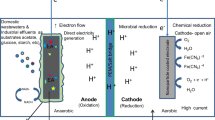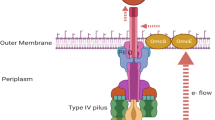Abstract
Microbial fuel cells are used for energy production, zero carbon dioxide emission and wastewater remediation. Textile industrial effluents contain organic and inorganic compounds that can fuel microbial fuel cells. Here, we review microorganisms that are used as biocatalyst for dye decolorization with energy production. We also present the most common electrodes, membranes and electrolytes used for dye decolorization with electricity production.

Similar content being viewed by others
References
Aelterman P, Rabaey K, Verstraete W (2006) Continuous electricity generation at high voltages and currents using stacked microbial fuel cells. Environ Sci Technol 40(10):3388–3394. doi:10.1021/es0525511
Ahmad R, Kumar R (2010) Adsorptive removal of congo red dye from aqueous solution using bael shell carbon. Appl Surf Sci 257(5):1628–1633
Ahn Y, Logan BE (2013) Saline catholytes as alternatives to phosphate buffers in microbial fuel cells. Bioresour Technol 132:436–439. doi:10.1016/j.biortech.2013.01.113
Balamurugan B, Thirumarimurugan M, Kannadasan T (2011) Anaerobic degradation of textile dye bath effluent using Halomonas sp. Bioresour Technol 102(10):6365–6369. doi:10.1016/j.biortech.2011.03.017
Cao Y, Hu Y, Sun J, Hou B (2010) Explore various co-substrates for simultaneous electricity generation and Congo red degradation in air-cathode single-chamber microbial fuel cell. Bioelectrochemistry 79:71–76. doi:10.1016/j.bioelechem.2009.12.001
Catal T, Xu S, Li K, Bermek H, Liu H (2008) Electricity generation from polyalcohols in single-chamber microbial fuel cells. Biosens Bioelectron 24:849–854. doi:10.1016/j.bios.2008.07.015
Chen BY, Zhang MM, Chang CT, Ding Y, Lin KL, Chiou C, Hsueh CC, Xu H (2010) Assessment upon azo dye decolorization and bioelectricity generation by Proteus hauseri. Bioresour Technol 101:4737–4741. doi:10.1016/j.biortech.2010.01.133
Chen Bor-Yann et al (2014) Exploring redox-mediating characteristics of textile dye-bearing microbial fuel cells: thionin and malachite green. Biores Technol 169:277–283. doi:10.1016/j.biortech.2014.06.084
Chen Bor-Yann et al (2015) Deciphering electron-shuttling characteristics of thionine-based textile dyes in microbial fuel cells. J Taiwan Inst Chem Eng 51:63–70. doi:10.1016/j.jtice.2014.12.031
Clauwaert P, Van Der Ha D, Boon N, Verbeken K, Verhaege M, Rabaey K, Verstraete W (2007) Open air biocathode enables effective electricity generation with microbial fuel cells. Environ Sci Technol 41:7564–7569. doi:10.1021/es0709831
Cui D, Guo YQ, Lee HS, Wu WM, Liang B, Wang AJ, Cheng HY (2014) Enhanced decolorization of azo dye in a small pilot-scale anaerobic baffled reactor coupled with biocatalyzed electrolysis system (ABR-BES): a design suitable for scaling-up. Bioresour Technol 163:254–261. doi:10.1016/j.biortech.2014.03.165
Ding H, Li Y, Lu A, Jin S, Quan C, Wang C, Wang X, Zeng C, Yan Y (2010) Photocatalytically improved azo dye reduction in a microbial fuel cell with rutile-cathode. Bioresour Technol 101:3500–3505. doi:10.1016/j.biortech.2009.11.107
Du Z, Li H, Gu T (2007) A state of the art review on microbial fuel cells: a promising technology for wastewater treatment and bioenergy. Biotechnol Adv 25:464–482. doi:10.1016/j.biotechadv.2007.05.004
Fan Y, Hu H, Liu H, Qian F, Morse DE, Mink JE, Qaisi RM, Logan BE, Hussain MM, Choi S, University Florida State (2015) Sustainable power generation in microbial fuel cells using bicarbonate buffer and proton transfer mechanisms. Biosens Bioelectron 69:e89. doi:10.1038/am.2014
Fang Z, Song HL, Cang N, Li XN (2013) Performance of microbial fuel cell coupled constructed wetland system for decolorization of azo dye and bioelectricity generation. Bioresour Technol 144:165–171. doi:10.1016/j.biortech.2013.06.073
Fang Zhou et al (2015) Electricity production from Azo dye wastewater using a microbial fuel cell coupled constructed wetland operating under different operating conditions. Biosens Bioelectron 68:135–141. doi:10.1016/j.bios.2014.12.047
Fernández de Dios MÁ, del Campo AG, Fernández FJ, Rodrigo M, Pazos M, Sanromán MÁ (2013) Bacterial-fungal interactions enhance power generation in microbial fuel cells and drive dye decolorisation by an ex situ and in situ electro-Fenton process. Bioresour Technol 148:39–46. doi:10.1016/j.biortech.2013.08.084
Goyal RN, Minocha Ashwani (1985) Electrochemical behaviour of the bisazo dye, direct red-81. J Electroanal Chem Interfacial Electrochem 193(1-2):231–240. doi:10.1016/0022-0728(85)85065-8
Harnisch F, Wirth S, Schröder U (2009) Electrochemistry communications effects of substrate and metabolite crossover on the cathodic oxygen reduction reaction in microbial fuel cells: platinum vs. iron (II) phthalocyanine based electrodes. Electrochem Commun 11:2253–2256. doi:10.1016/j.elecom.2009.10.002
He P, Xu Y, Fang Y (2006) Applications of carbon nanotubes in electrochemical DNA biosensors. Microchim Acta 152:175–186. doi:10.1007/s00604-005-0445-1
He Z, Huang Y, Manohar AK, Mansfeld F (2008) Effect of electrolyte pH on the rate of the anodic and cathodic reactions in an air–cathode microbial fuel cell. Bioelectrochemistry 74:78–82. doi:10.1016/j.bioelechem.2008.07.007
Heijne ATER, Wilde VDE (2006) A bipolar membrane combined with ferric iron reduction as an efficient cathode system in microbial fuel. Environ Sci Technol 40(17):5200–5205. doi:10.1021/es0608545
Hou B, Sun J, Hu YY (2011) Simultaneous Congo red decolorization and electricity generation in air-cathode single-chamber microbial fuel cell with different microfiltration, ultrafiltration and proton exchange membranes. Bioresour Technol 102:4433–4438. doi:10.1016/j.biortech.2010.12.092
Hou B, Hu Y, Sun J (2012) Performance and microbial diversity of microbial fuel cells coupled with different cathode types during simultaneous azo dye decolorization and electricity generation. Bioresour Technol 111:105–110. doi:10.1016/j.biortech.2012.02.017
Jayaprakash J, Parthasarathy A, Viraraghavan R (2016) Decolorization and degradation of monoazo and diazo dyes in Pseudomonas catalyzed microbial fuel cell. Environ Prog Sustain Energy 35:1623–1628. doi:10.1002/ep.12397
Jayapriya J, Ramamurthy V (2012) Use of non-native phenazines to improve the performance of Pseudomonas aeruginosa MTCC 2474 catalysed fuel cells. Bioresour Technol 124:23–28. doi:10.1016/j.biortech.2012.08.034
Jayapriya J, Ramamurthy V (2014) The role of electrode material in capturing power generated in Pseudomonas catalysed fuel cells. Can J Chem Eng 92:610–614. doi:10.1002/cjce.21895
Jayapriya J, Ramamurthy V (2015) Challenges to and opportunities in microbial fuel cells. In: Navanietha Krishnaraj R, Yu J-S (eds) Bioenergy: opportunities and challenges. Apple Academic Press, Oakville, pp 87–124
Jayapriya J, Gopal J, Ramamurthy V, Kamachi Mudali U, Raj B (2012) Preparation and characterization of biocompatible carbon electrodes. Compos Part B Eng 43:1329–1335. doi:10.1016/j.compositesb.2011.10.019
Kalathil S, Lee J, Cho MH (2011) Granular activated carbon based microbial fuel cell for simultaneous decolorization of real dye wastewater and electricity generation. N Biotechnol. 29:32–37. doi:10.1016/j.nbt.2011.04.014
Kalathil S, Lee J, Cho MH (2012) Efficient decolorization of real dye wastewater and bioelectricity generation using a novel single chamber biocathode-microbial fuel cell. Bioresour Technol 119:22–27. doi:10.1016/j.biortech.2012.05.059
Kang YL, Pichiah S, Ibrahim S (2016) Facile reconstruction of microbial fuel cell (MFC) anode with enhanced exoelectrogens selection for intensified electricity generation. Int J Hydrog Energy. doi:10.1016/j.ijhydene.2016.09.059
Kim JR, Cheng S, Oh SE, Logan BE (2007) Power generation using different cation, anion, and ultrafiltration membranes in microbial fuel cells. Environ Sci Technol 41:1004–1009. doi:10.1021/es062202m
Kumar R, Ahmad R (2011) Biosorption of hazardous crystal violet dye from aqueous solution onto treated ginger waste (TGW). Desalination 265(1):112–118. doi:10.1016/j.desal.2010.07.040
Kumar S, Bhanjana G, Jangra K, Dilbaghi N, Umar A (2014) Utilization of carbon nanotubes for the removal of rhodamine B dye from aqueous solutions. J Nanosci Nanotechnol 14:4331–4336. doi:10.1166/jnn.2014.8077
Li Z, Zhang X, Lin J, Han S, Lei L (2010) Azo dye treatment with simultaneous electricity production in an anaerobic–aerobic sequential reactor and microbial fuel cell coupled system. Bioresour Technol 101:4440–4445. doi:10.1016/j.biortech.2010.01.114
Liu L, Li FB, Feng CH, Li XZ (2009) Microbial fuel cell with an azo-dye-feeding cathode. Appl Microbiol Biotechnol 85:175–183. doi:10.1007/s00253-009-2147-9
Logan BE, Regan JM (2006) Microbial fuel cells—challenges and applications. Environ Sci Technol 40:5172–5180. doi:10.1021/es0627592
Logan BE, Murano C, Scott K, Gray ND, Head IM (2005) Electricity generation from cysteine in a microbial fuel cell. Water Res 39:942–952. doi:10.1016/j.watres.2004.11.019
Lovley DR (2006) Microbial fuel cells: novel microbial physiologies and engineering approaches. Curr Opin Biotechnol 17:327–332. doi:10.1016/j.copbio.2006.04.006
Mash HE, Chin YP, Sigg L, Hari R, Xue H (2003) Complexation of copper by zwitterionic aminosulfonic (good) buffers. Anal Chem 75:671–677. doi:10.1021/ac0261101
Menek Necati, Karaman Yeliz (2005) Polarographic and voltammetric investigation of 8-hydroxy-7-(4-sulfo-1-naphthylazo)-5-quinoline sulfonic acid. Dyes Pigm 67(1):9–14. doi:10.1016/j.dyepig.2004.10.002
Mu Y, Rabaey K, Rozendal RA, Yuan Z, Keller J (2009) Decolorization of azo dyes in bioelectrochemical systems. Environ Sci Technol 43:5137–5143. doi:10.1021/es900057f
Niu CG, Wang Y, Zhang XG, Zeng GM, Huang DW, Ruan M, Li XW (2012) Decolorization of an azo dye orange G in microbial fuel cells using Fe(II)-EDTA catalyzed persulfate. Bioresour Technol 126:101–106. doi:10.1016/j.biortech.2012.09.001
Oh SE, Logan BE (2006) Proton exchange membrane and electrode surface areas as factors that affect power generation in microbial fuel cells. Appl Microbiol Biotechnol 70:162–169. doi:10.1007/s00253-005-0066-y
Popli S, Patel UD (2015) Destruction of azo dyes by anaerobic–aerobic sequential biological treatment: a review. Int J Environ Sci Technol 12(1):405–420. doi:10.1007/s13762-014-0499-x
Rabaey K, Verstraete W (2005) Microbial fuel cells: novel biotechnology for energy generation. Trends Biotechnol 23:291–298. doi:10.1016/j.tibtech.2005.04.008
Rajaguru P et al (2002) Genotoxicity evaluation of polluted ground water in human peripheral blood lymphocytes using the comet assay. Mutat Res Genet Toxicol Environ Mutagenesis 517(1):29–37. doi:10.1016/S1383-5718(02)00025-6
Savizi ISP, Kariminia HR, Bakhshian S (2012) Simultaneous decolorization and bioelectricity generation in a dual chamber microbial fuel cell using electropolymerized-enzymatic cathode. Environ Sci Technol 46(12):6584–6593. doi:10.1021/es300367h
Senan Resmi C, Emilia Abraham T (2004) Bioremediation of textile azo dyes by aerobic bacterial consortium aerobic degradation of selected azo dyes by bacterial consortium. Biodegradation 15(4):275–280. doi:10.1023/B:BIOD.0000043000.18427.0a
Shantaram A, Beyenal H, Raajan R, Veluchamy A, Lewandowski Z (2005) Wireless sensors powered by microbial fuel cells. Environ Sci Technol 39:5037–5042. doi:10.1021/es0480668
Shukla AK, Suresh P, Berchmans S, Rajendran A (2004) Biological fuel cells and their applications. Curr Sci 87(4):455–468
Sun J, Hu Y, Bi YZ, Cao YQ (2009a) Simultaneous decolorization of azo dye and bioelectricity generation using a microfiltration membrane air-cathode single-chamber microbial fuel cell. Bioresour Technol 100:3185–3192. doi:10.1016/j.biortech.2009.02.002
Sun J, Hu Y, Bi Z, Cao Y (2009b) Improved performance of air-cathode single-chamber microbial fuel cell for wastewater treatment using microfiltration membranes and multiple sludge inoculation. J Power Sources 187:471–479. doi:10.1016/j.jpowsour.2008.11.022
Sun Jian, Hu Y, Hou B (2011) Electrochemical characterization of the bioanode during simultaneous azo dye decolorization and bioelectricity generation in an air-cathode single chambered microbial fuel cell. Electrochim Acta 56(19):6874–6879. doi:10.1016/j.electacta.2011.05.111
Sun J, Li Y, Hu Y, Hou B, Xu Q, Zhang Y, Li S (2012) Enlargement of anode for enhanced simultaneous azo dye decolorization and power output in air–cathode microbial fuel cell. Biotechnol Lett 34:2023–2029. doi:10.1007/s10529-012-1002-8
Sun J, Li W, Li Y, Hu Y, Zhang Y (2013) Redox mediator enhanced simultaneous decolorization of azo dye and bioelectricity generation in air–cathode microbial fuel cell. Bioresour Technol 142:407–414. doi:10.1016/j.biortech.2013.05.039
Sun J, Cai B, Zhang Y, Peng Y, Chang K, Ning X, Liu G, Yao K, Wang Y, Yang Z, Liu J (2016) Regulation of biocathode microbial fuel cell performance with respect to azo dye degradation and electricity generation via the selection of anodic inoculum. Int J Hydrog Energy 41:5141–5150. doi:10.1016/j.ijhydene.2016.01.114
Tan CW, Tan KH, Ong YT, Mohamed AR, Zein SHS, Tan SH (2012) Energy and environmental applications of carbon nanotubes. Environ Chem Lett 10:265. doi:10.1007/s10311-012-0356-4
Thung WE, Ong SA, Ho LN, Wong YS, Ridwan F, Oon YL, Oon YS, Lehl HK (2015) A highly efficient single chambered up-flow membrane-less microbial fuel cell for treatment of azo dye Acid Orange 7-containing wastewater. Bioresour Technol 197:284–288. doi:10.1016/j.biortech.2015.08.078
You S, Zhao Q, Zhang J, Jiang J, Zhao S (2006) A microbial fuel cell using permanganate as the cathodic electron acceptor. J Power Sources 162:1409–1415. doi:10.1016/j.jpowsour.2006.07.063
Zhou M, Chi M, Luo J, He H, Jin T (2011) An overview of electrode materials in microbial fuel cells. J Power Sources 196:4427–4435. doi:10.1016/j.jpowsour.2011.01.012
Acknowledgements
We thank UGC-RGNF for support with doctoral fellowship (to Ilamathi R – F1 – 17.1/2014-15/RGNF-2014-15-SC-TAM-58583). The authors gratefully acknowledge the financial support provided by BRNS, Mumbai (2013/37C/47/BRNS/2189-7).
Author information
Authors and Affiliations
Corresponding author
Rights and permissions
About this article
Cite this article
Ilamathi, R., Jayapriya, J. Microbial fuel cells for dye decolorization. Environ Chem Lett 16, 239–250 (2018). https://doi.org/10.1007/s10311-017-0669-4
Received:
Accepted:
Published:
Issue Date:
DOI: https://doi.org/10.1007/s10311-017-0669-4




